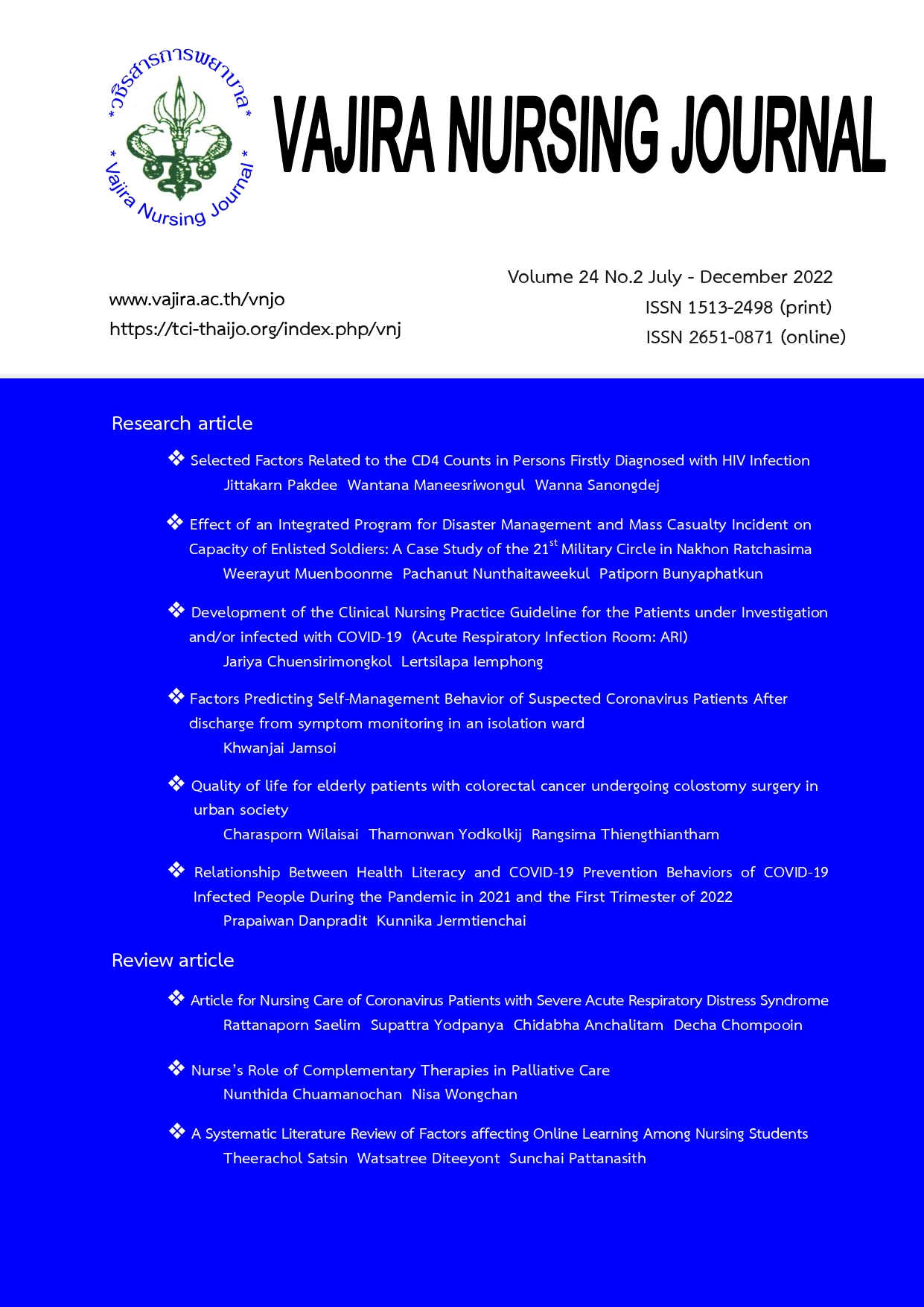ปัจจัยทำนายพฤติกรรมการจัดการตนเองของผู้ป่วย ต้องสงสัยติดเชื้อไวรัสโคโรน่าภายหลังจำหน่าย จากการเฝ้าติดตามอาการในหอผู้ป่วยแยกโรค
Main Article Content
บทคัดย่อ
วิจัยนี้เป็นการวิจัยเชิงสำรวจ (cross-sectional study) ศึกษาปัจจัยทำนายพฤติกรรมการจัดการตนเองของผู้ป่วยต้องสงสัยติดเชื้อไวรัสโคโรน่า ภายหลังจำหน่ายจากการเฝ้าติดตามอาการในหอผู้ป่วยแยกโรค กลุ่มตัวอย่าง คือ ผู้ป่วยต้องสงสัยติดเชื้อไวรัสโคโรนาระหว่างเดือนกุมภาพันธ์ถึงเดือนพฤษภาคม พ.ศ.2563 ทั้งหมด เพื่อศึกษาพฤติกรรมการจัดการตนเองของผู้ป่วยต้องสงสัยติดเชื้อไวรัสโคโรนา ภายหลังได้รับการเฝ้าติดตามอาการในหอผู้ป่วยแยกโรค และศึกษาความเครียด การรับรู้ความเจ็บป่วย การสื่อสารระหว่างผู้ป่วยกับเจ้าหน้าที่สุขภาพต่อพฤติกรรมการจัดการตนเองของผู้ป่วยต้องสงสัยติดเชื้อไวรัสโคโรนา ผลการศึกษาพบว่า มีผู้ป่วยต้องสงสัยติดเชื้อไวรัสโคโรนา ระหว่างเดือนกุมภาพันธ์ ถึงเดือนพฤษภาคม พ.ศ.2563 จำนวนรวม 50 ราย มีอายุเฉลี่ย 42.5 ปี และมีระยะเวลาวันนอนโรงพยาบาลเฉลี่ย 2.68 วัน ความเครียดภาพรวมอยู่ในระดับเครียดมาก และมีพฤติกรรมการดูแลตนเองมากสุด เช่น การทำความสะอาดบ้าน การเปิดระบายอากาศและทำความสะอาดวัตถุบริเวณที่ถูกสัมผัสบ่อย ๆ การเว้นระยะห่างทางสังคมอย่างน้อย 1 -2 เมตร เป็นต้นและความเครียดไม่มีผลต่อพฤติกรรมการจัดการตนเอง แต่การสื่อสารระหว่างผู้ป่วยกับเจ้าหน้าที่สุขภาพมีผลต่อพฤติกรรมการจัดการตนเองของผู้ป่วยอย่างมีนัยสำคัญทางสถิติ (P<0.5) และการสื่อสารมีผลต่อความเครียดของผู้ป่วยอย่างมีนัยสำคัญทางสถิติ (P<0.5)
Article Details

อนุญาตภายใต้เงื่อนไข Creative Commons Attribution-NonCommercial-NoDerivatives 4.0 International License.
เนื้อหาและข้อมูลในบทความที่ลงตีพิมพ์ในวชิรสารการพยาบาลถือเป็นข้อคิดเห็นและความรับผิดชอบของผู้เขียนบทความโดยตรง ซึ่งกองบรรณาธิการไม่จำเป็นต้องเห็นด้วย หรือร่วมรับผิดชอบใด ๆ ทั้งสิ้น
บทความ ข้อมูล เนื้อหา รูปภาพ ฯลฯ ที่ได้รับการตีพิมพ์ในวชิรสารการพยาบาล ถือเป็นลิขสิทธิ์ของวชิรสารการพยาบาล หากบุคคลใดหรือหน่วยงานใดต้องการนำทั้งหมดหรือส่วนหนึ่งส่วนใดไปเผยแพร่ต่อหรือเพื่อกระทำการใด ๆ จะต้องได้รับอนุญาตเป็นลายลักอักษรจากวชิรสารการพยาบาลก่อนเท่านั้น
เอกสารอ้างอิง
กระทรวงสาธารณสุข. โรคติดเชื้อไวรัสโคโรนา 2019 (COVID-19). (เข้าถึงเมื่อ 7 ม.ค. 2565). Retrieved from https://ddc.moph.go.th/ viralpneumonia/
แพทยสภา. รายงานสถานการณ์โควิด-19 (เข้าถึงเมื่อ 7 ม.ค. 2565). Retrieved from https:// tmc.or.th/covid19/
Broadbent E, Petrie KJ, Main J, Weinman J. The brief illness perception questionnaire. Journal of psychosomatic research. 2006; 60(6), 631–637.
Rothan HA, Byrareddy SN. (2020). The epidemiology and pathogenesis of coronavirus disease (COVID-19) outbreak. J Autoimmun. 2020; 109, 102433.
World Health Organization. Coronacirus disease 2019; 2019. Retrieved from https://www.who.int/emergencies/diseases/novel-coronavirus-2019/global-research-on-novel-coronavirus-2019-ncov
Xiao H, Zhang Y, Kong D, Li S, Yang N. The Effects of Social Support on Sleep Quality of Medical Staff Treating Patients with Coronavirus Disease 2019 (COVID-19) in January and February 2020 in China. Med Sci Monit. 2020;26, e923549.
เวชสถิติผู้รับบริการคณะแพทยศาสตร์วชิรพยาบาล. สถิติผู้ป่วยประจำปีงบประมาณ 2563. คณะแพทยศาสตร์วชิรพยาบาล มหาวิทยาลัย นวมินทราธิราช.


